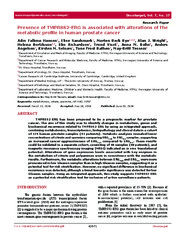| dc.contributor.author | Hansen, Ailin Falkmo | |
| dc.contributor.author | Sandsmark, Elise | |
| dc.contributor.author | Rye, Morten Beck | |
| dc.contributor.author | Wright, Alan J | |
| dc.contributor.author | Bertilsson, Helena | |
| dc.contributor.author | Richardsen, Elin | |
| dc.contributor.author | Viset, Trond | |
| dc.contributor.author | Bofin, Anna M. | |
| dc.contributor.author | Angelsen, Anders | |
| dc.contributor.author | Selnæs, Kirsten Margrete | |
| dc.contributor.author | Bathen, Tone Frost | |
| dc.contributor.author | Tessem, May-Britt | |
| dc.date.accessioned | 2017-01-24T08:44:21Z | |
| dc.date.available | 2017-01-24T08:44:21Z | |
| dc.date.issued | 2016-06-03 | |
| dc.description.abstract | TMPRSS2-ERG has been proposed to be a prognostic marker for prostate
cancer. The aim of this study was to identify changes in metabolism, genes and
biochemical recurrence related to TMPRSS2-ERG by using an integrated approach,
combining metabolomics, transcriptomics, histopathology and clinical data in a cohort
of 129 human prostate samples (41 patients). Metabolic analyses revealed lower
concentrations of citrate and spermine comparing ERGhigh to ERGlow samples, suggesting
an increased cancer aggressiveness of ERGhigh compared to ERGlow. These results
could be validated in a separate cohort, consisting of 40 samples (40 patients), and
magnetic resonance spectroscopy imaging (MRSI) indicated an in vivo translational
potential. Alterations of gene expression levels associated with key enzymes in
the metabolism of citrate and polyamines were in consistence with the metabolic
results. Furthermore, the metabolic alterations between ERGhigh and ERGlow were more
pronounced in low Gleason samples than in high Gleason samples, suggesting it as a
potential tool for risk stratification. However, no significant difference in biochemical
recurrence was detected, although a trend towards significance was detected for low
Gleason samples. Using an integrated approach, this study suggests TMPRSS2-ERG
as a potential risk stratification tool for inclusion of active surveillance patients. | en_US |
| dc.description | This article is also available at <a href="10.18632/oncotarget.9817">10.18632/oncotarget.9817</a><br>
This is an article under the terms of the <a href="https://creativecommons.org/licenses/by/3.0/">Creative Commons Attribution 3.0 License</a>, which permits use and distribution in any medium, provided the original work is properly cited, the use is non-commercial and no modifications or adaptations are made. | en_US |
| dc.identifier.citation | OncoTarget 2016 | en_US |
| dc.identifier.cristinID | FRIDAID 1380280 | |
| dc.identifier.doi | 10.18632/oncotarget.9817 | |
| dc.identifier.issn | 1949-2553 | |
| dc.identifier.uri | https://hdl.handle.net/10037/10191 | |
| dc.language.iso | eng | en_US |
| dc.publisher | Impact Journals | en_US |
| dc.rights.accessRights | openAccess | en_US |
| dc.subject | VDP::Medisinske Fag: 700::Klinisk medisinske fag: 750::Onkologi: 762 | en_US |
| dc.subject | VDP::Medical disciplines: 700::Clinical medical disciplines: 750::Oncology: 762 | en_US |
| dc.title | Presence of TMPRSS2-ERG is associated with alterations of the metabolic profile in human prostate cancer | en_US |
| dc.type | Tidsskriftartikkel | en_US |
| dc.type | Peer reviewed | en_US |
| dc.type | Journal article | en_US |


 English
English norsk
norsk